If you’ve ever spent a humid summer night on the Gulf Coast, just after dusk descends, you might’ve been met with a scene from a sci-fi movie. Clouds of insects swarm every light source, their wings buzzing incessantly. They flit around your face, and you hear a disconcerting crunch beneath your foot with every step. These aren’t typical moths or mosquitoes. Formosan termites are invasive pests that wreak havoc on homes and wallets. Unlike their subterranean counterparts, Formosan termites can establish colonies above ground, infesting structures without any contact with the soil. Their teardrop-shaped heads and hairy wings are a dead giveaway, but by the time they’re spotted, the damage might already be done. These unwelcome invaders cause millions of dollars in property damage each year, leaving residents with fond memories of pre-termite days and a desperate scramble to find solutions.
Imagine termites the size of a thumb, munching their way through a warehouse. That’s the reality of Formosan termites, a terrifying example of how invasive pests can wreak havoc. The World Trade Organization (WTO) established the International Standards for Phytosanitary Measures (ISPM) to combat such threats. ISPM 15 regulates explicitly the transportation of wood packaging materials like pallets, mandating treatment to prevent the spread of insects and other organisms during international trade. While ISPM 15 is crucial, its regulations can be an added expense for businesses. This has spurred the development of ISPM-compliant pallets made from alternative materials like heat-treated plastic or recycled materials. These alternatives can bring down costs and increase durability.
What Is an ISPM Pallet?

The International Plant Protection Convention (IPPC) plays a vital role in preventing the spread of harmful insects through international trade. A key element of this effort is ISPM 15, which mandates that these materials be debarked to the greatest extent possible. While removing all bark isn’t required, the regulation outlines specific allowances. Small bark fragments narrower than a credit card can remain, and larger pieces exceeding that width are permitted as long as their total surface area is smaller than a standard Post-It note. Once debarked, the wood undergoes heat treatment or fumigation to eliminate any remaining insects. Finally, compliant wood packaging receives a unique ISPM 15 stamp, often called the “wheat stamp,” signifying its adherence to international phytosanitary regulations.
Two main treatment options exist to ensure wood pallets meet ISPM 15 standards and travel the globe insect-free. Pallets can be heat-blasted to a scorching 56°C (132.8°F) for at least 30 minutes, eliminating any insects hiding within. Alternatively, they can undergo methyl bromide fumigation, where they’re sealed in a container and exposed to this gas for 24 hours. Both methods have variations depending on the treatment facility. These treatments can be customized to some extent depending on where they take place:
- Steady Heat Treatment: The most common method is steady heat treatment, which involves placing debarked lumber in a large chamber. The chamber is then heated to a specific temperature for a set duration, eliminating any insects present.
- Kiln-Dried Treatment: This process combines heat treatment for insects with precise moisture control. Debarked lumber is placed in a chamber similar to steady heat treatment, but moisture levels are carefully monitored and reduced here. This is the same drying method used for high-quality furniture wood.
- Mobile Heat Treatment: This method offers on-site treatment for pallets. A special chamber mounted on a truck acts like a portable oven, heating the wood to eliminate insects. However, it can only handle smaller quantities at a time.
- Container Heat Treatment: This method heats the lumber inside the shipping container, making it a convenient option for portside treatment before international voyages.
- Fumigation Methods (Methyl Bromide): For these methods, debarked lumber is locked away in a sealed container. Methyl bromide gas is pumped in for 24 hours. After that, the container is aired out, and the lumber is ready. This process can be done in either a shipping container or a special tent, with the tent method allowing for larger batches and more flexibility.
Once the wood packaging undergoes heat or chemical treatment, it receives its official seal of approval: the ISPM stamp, often called the “wheat stamp” due to its design. This stamp functions like a passport for the wood, allowing it to travel freely. The stamp includes a two-letter country code (like US for the United States), an identification number for the wood treatment facility’s regulatory agency, a unique manufacturer ID, and finally, a treatment code – “HT” for heat treatment or “MB” for methyl bromide. While both options exist, heat treatment reigns supreme due to methyl bromide’s environmental and health hazards.
ISPM 15, the gold standard for treating wood packaging in international trade, isn’t universally applied. Pallets used solely within a country are exempt, which can cause confusion as domestic shipments sometimes cross state lines unintentionally. While the U.S. and Canada previously enjoyed an exemption for pallet movement, this is being phased out. This changing landscape and the mixing of pallets throughout the supply chain create challenges in ensuring compliance with ISPM 15 or other relevant regulations. Manufacturers must also stay vigilant of evolving enforcement practices to avoid costly violations.
Bypassing ISPM 15 Requirements with a Safer Pallet

ISPM 15 compliance is crucial for imports. In recent years, U.S. Customs and Border Protection (CBP) tightened enforcement. Now, a single instance of non-compliant wood packaging on imported goods can result in penalties and potential seizure. This can disrupt your supply chain and lead to contract breaches.
ISPM 15 regulates wood packaging to ensure safe international trade. However, damaged ISPM stamps on wood pallets can lead to penalties. ISPM 15-exempt plastic pallets offer several advantages for companies seeking a hassle-free alternative.
These offer several benefits: they’re bug-resistant and easy to clean, last longer than wood, are lighter weight for potentially lower shipping costs, and work well with automated systems. Renting plastic pallets through a pooling service makes them price-competitive with wood pallets while ensuring a reliable supply and eliminating the need for in-house pallet management.
Read more: What are the Advantages of Plastic Pallets Over Wooden Pallets for Pooling?
Manufacturers worried about termite infestations can opt for iGPS plastic pallets, which are exempt from ISPM 15 requirements. These pallets are bug-resistant and easy to clean, and contribute to a sustainable and climate-resilient supply chain. For more information, contact us at 1-800-884-0225, email a specialist at switch@igps.net, or visit our contact page.



